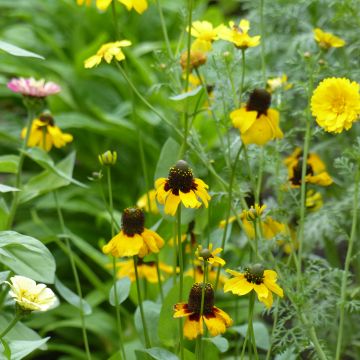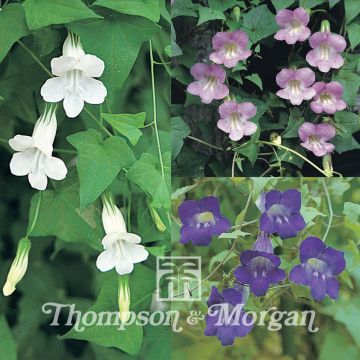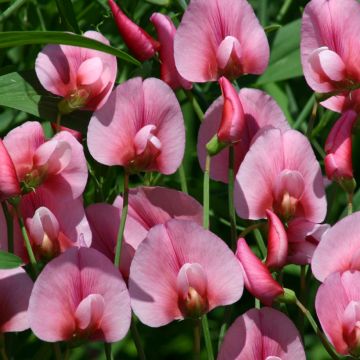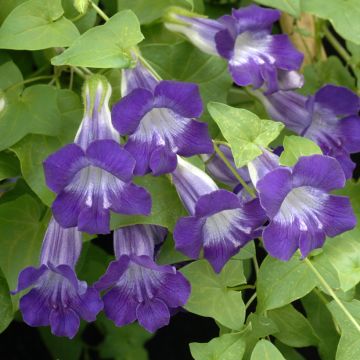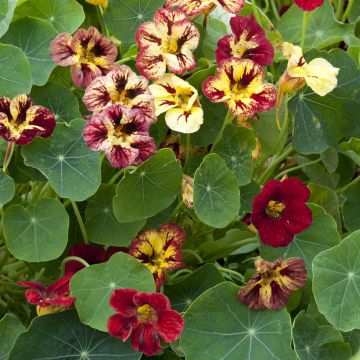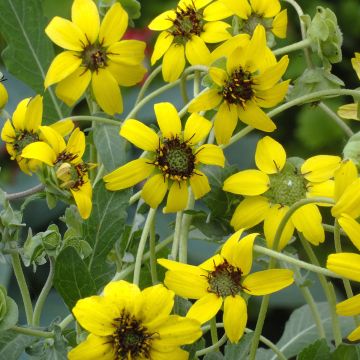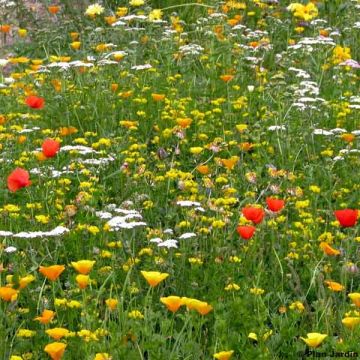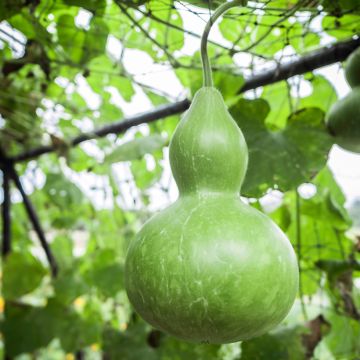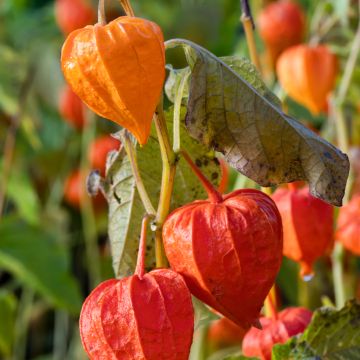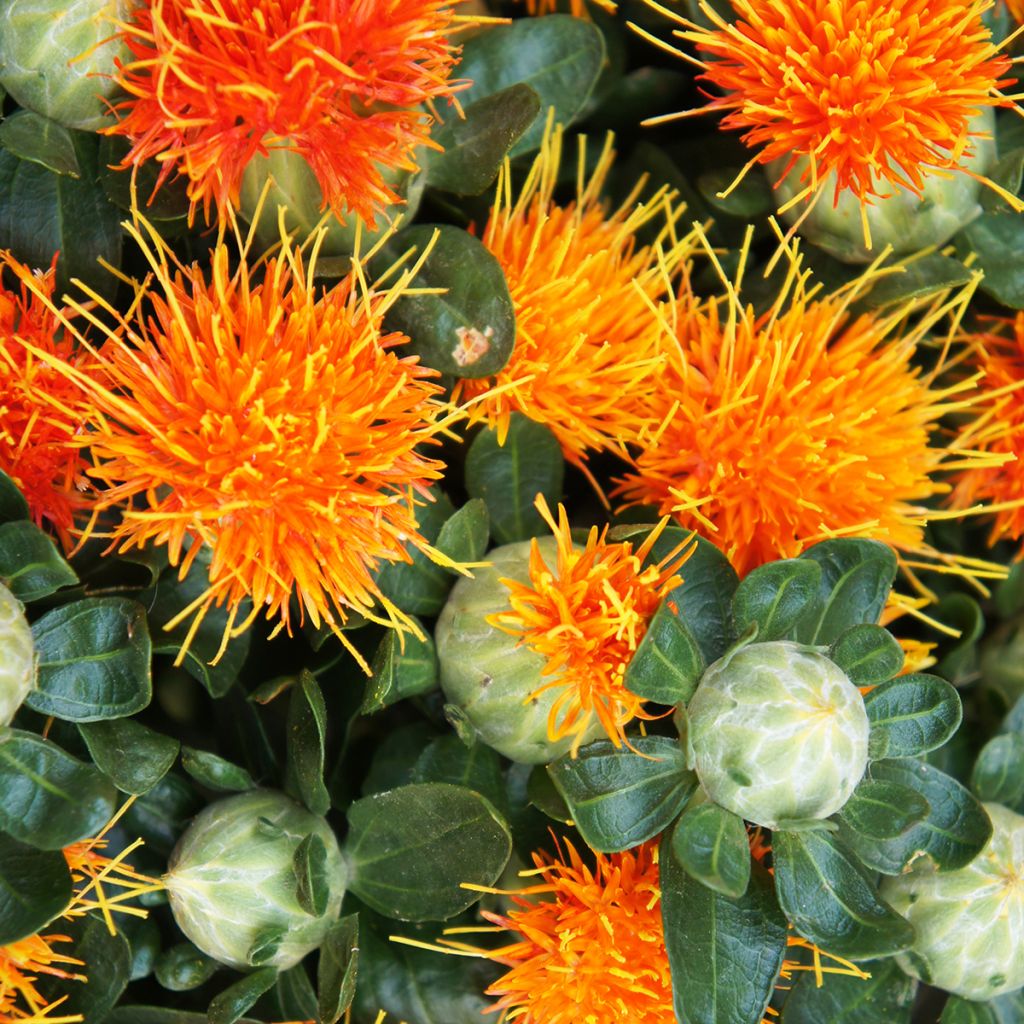

Carthamus tinctorius Zanzibar - seeds
Carthamus tinctorius Zanzibar - seeds
Carthamus tinctorius Zanzibar
Safflower, False Saffron, Bastard Saffron
This item cannot be shipped to the selected country
Dispatch by letter from €3.90
Delivery to Corse prohibited
More information
Schedule delivery date,
and select date in basket
This plant carries a 6 months recovery warranty
More information
We guarantee the quality of our plants for a full growing cycle, and will replace at our expense any plant that fails to recover under normal climatic and planting conditions.
Seed-only orders are dispatched by sealed envelope. The delivery charge for seed-only orders is €3.90.
Delivery to Corse prohibited: UE law prohibits the import of this plant from mainland France to Corse as part of the fight against Xylella fastidiosa. Please accept our sincere apologies.
More information
Does this plant fit my garden?
Set up your Plantfit profile →
Description
Carthamus tinctorius 'Zanzibar' is a selection of achene safflower with sparsely spiny foliage and large, original and colourful orange flowers. The classic variety is an annual plant of beautiful stature, formerly cultivated for the red and yellow pigments extracted from its flowers, but also for its oilseeds. 'Zanzibar' forms a beautiful tuft adorned with orange pompoms that are eye-catching in summer. Sown in spring under heated shelter, it will produce beautiful flowers for dried bouquets.
Carthamus tinctorius 'Zanzibar' is a horticultural selection. The achene safflower, also called Dyer's saffron or False saffron, is an annual plant of the asteraceae family that has been domesticated by humans for a long time. It does not exist in the wild. Its ancestor is probably Carthamus persicus, native to central and eastern Turkey and Iran. It is a plant of arid zones subject to seasonal rains. The safflower develops a very deep taproot that allows it to survive in this type of environment. The plant germinates, flowers, produces seeds and dies within 4 to 5 months.
The 'Zanzibar' orange selection forms a highly branched clump of 70-80 cm in height with a thistle-like appearance. The plant develops a rosette of basal leaves, without petioles, lanceolate to elliptical, measuring 7 to 15 cm long and 2.5 to 6 cm wide, with toothed edges. As the day length and temperature increase, whitish, highly branched stems rise from the rosette. They bear more rounded, non-prickly leaves, which decrease in size towards the top of the stem. Flowering occurs in summer, 3 to 4 months after sowing. Each branching stem bears up to 5 heads comprising 15 to 20 capitula. Each flower in the capitulum measures between 3 and 4 cm in diameter, and has multiple orange petals or ligules enclosed in green bracts. The overall appearance is somewhat tousled. After pollination, fruits called achenes are formed. They are ovoid, 5 to 8 mm long and have 4 angles. They are ripe when the leaves turn brown. Safflower seeds can be harvested for resowing the following year. They are rich in oil and attract certain birds at the end of the season.
The 'Zanzibar' safflower requires warmth and does not like humidity; its foliage is quite susceptible to fungal diseases and it dislikes cool and rainy climates. It should be planted in full sun, in light and well-drained soil. Greenhouse cultivation is possible in all regions. It can be planted in open ground, in the vegetable garden or in a flower bed, as soon as the risk of frost has passed. A large country-style flower bed can be created by associating it with thistles and medium-height ornamental grasses.
For dried bouquets: pick and dry the flowers when they are still in bud, just barely open.
Safflower in cooking:
Roasted seeds can be consumed as an appetiser. Young leaves can be eaten raw in salads or steamed.
An ecological asset:
Throughout the summer, the nectar-rich flowers of safflowers attract pollinating insects and butterflies to your garden. The oil-rich seeds are particularly appreciated by some birds (Parrots, Tits, etc.). You can harvest them after flowering.
Report an error about the product description
Flowering
Foliage
Plant habit
Botanical data
Carthamus
tinctorius
Zanzibar
Asteraceae
Safflower, False Saffron, Bastard Saffron
Carthamus tinctorius Zanzibar
Cultivar or hybrid
Other Flower seeds
Planting and care
Sow Zanzibar Safflower under heated shelter (20 °C) in March-April. Direct sowing in open ground will be possible after frosts, in regions where spring is early and the growing season is long. Use good quality soil sifted on the surface to bind the seed to its substrate. Before sowing, lightly press the soil with a board. Sow your seeds by broadcasting. Cover the seeds by sprinkling soil or vermiculite on top, lightly press and water generously with a fine rain. Place your pots in light, without direct sunlight, at a temperature of 20°C to 25°C.
The seeds will germinate in 7 to 21 days. Keep the soil moist, but not excessively during growth.
By the end of May or early June, the temperature will be warm enough in the garden to plant your young plants. Choose a very sunny location. The soil should be loose and well-drained. Space your plants 60 cm apart. Weed if necessary, as safflower does not like competition from other plants.
Protect your seedlings from attacks by snails and slugs, which are fond of them.
Safflower sowing is as easy as sunflower sowing, but its cultivation is more delicate: the plant is sensitive to excess moisture, both in the soil and in the foliage. Once well-rooted, it tolerates water shortage very well.
Sowing period
Intended location
This item has not been reviewed yet - be the first to leave a review about it.
Haven't found what you were looking for?
Hardiness is the lowest winter temperature a plant can endure without suffering serious damage or even dying. However, hardiness is affected by location (a sheltered area, such as a patio), protection (winter cover) and soil type (hardiness is improved by well-drained soil).

Photo Sharing Terms & Conditions
In order to encourage gardeners to interact and share their experiences, Promesse de fleurs offers various media enabling content to be uploaded onto its Site - in particular via the ‘Photo sharing’ module.
The User agrees to refrain from:
- Posting any content that is illegal, prejudicial, insulting, racist, inciteful to hatred, revisionist, contrary to public decency, that infringes on privacy or on the privacy rights of third parties, in particular the publicity rights of persons and goods, intellectual property rights, or the right to privacy.
- Submitting content on behalf of a third party;
- Impersonate the identity of a third party and/or publish any personal information about a third party;
In general, the User undertakes to refrain from any unethical behaviour.
All Content (in particular text, comments, files, images, photos, videos, creative works, etc.), which may be subject to property or intellectual property rights, image or other private rights, shall remain the property of the User, subject to the limited rights granted by the terms of the licence granted by Promesse de fleurs as stated below. Users are at liberty to publish or not to publish such Content on the Site, notably via the ‘Photo Sharing’ facility, and accept that this Content shall be made public and freely accessible, notably on the Internet.
Users further acknowledge, undertake to have ,and guarantee that they hold all necessary rights and permissions to publish such material on the Site, in particular with regard to the legislation in force pertaining to any privacy, property, intellectual property, image, or contractual rights, or rights of any other nature. By publishing such Content on the Site, Users acknowledge accepting full liability as publishers of the Content within the meaning of the law, and grant Promesse de fleurs, free of charge, an inclusive, worldwide licence for the said Content for the entire duration of its publication, including all reproduction, representation, up/downloading, displaying, performing, transmission, and storage rights.
Users also grant permission for their name to be linked to the Content and accept that this link may not always be made available.
By engaging in posting material, Users consent to their Content becoming automatically accessible on the Internet, in particular on other sites and/or blogs and/or web pages of the Promesse de fleurs site, including in particular social pages and the Promesse de fleurs catalogue.
Users may secure the removal of entrusted content free of charge by issuing a simple request via our contact form.
The flowering period indicated on our website applies to countries and regions located in USDA zone 8 (France, the United Kingdom, Ireland, the Netherlands, etc.)
It will vary according to where you live:
- In zones 9 to 10 (Italy, Spain, Greece, etc.), flowering will occur about 2 to 4 weeks earlier.
- In zones 6 to 7 (Germany, Poland, Slovenia, and lower mountainous regions), flowering will be delayed by 2 to 3 weeks.
- In zone 5 (Central Europe, Scandinavia), blooming will be delayed by 3 to 5 weeks.
In temperate climates, pruning of spring-flowering shrubs (forsythia, spireas, etc.) should be done just after flowering.
Pruning of summer-flowering shrubs (Indian Lilac, Perovskia, etc.) can be done in winter or spring.
In cold regions as well as with frost-sensitive plants, avoid pruning too early when severe frosts may still occur.
The planting period indicated on our website applies to countries and regions located in USDA zone 8 (France, United Kingdom, Ireland, Netherlands).
It will vary according to where you live:
- In Mediterranean zones (Marseille, Madrid, Milan, etc.), autumn and winter are the best planting periods.
- In continental zones (Strasbourg, Munich, Vienna, etc.), delay planting by 2 to 3 weeks in spring and bring it forward by 2 to 4 weeks in autumn.
- In mountainous regions (the Alps, Pyrenees, Carpathians, etc.), it is best to plant in late spring (May-June) or late summer (August-September).
The harvesting period indicated on our website applies to countries and regions in USDA zone 8 (France, England, Ireland, the Netherlands).
In colder areas (Scandinavia, Poland, Austria...) fruit and vegetable harvests are likely to be delayed by 3-4 weeks.
In warmer areas (Italy, Spain, Greece, etc.), harvesting will probably take place earlier, depending on weather conditions.
The sowing periods indicated on our website apply to countries and regions within USDA Zone 8 (France, UK, Ireland, Netherlands).
In colder areas (Scandinavia, Poland, Austria...), delay any outdoor sowing by 3-4 weeks, or sow under glass.
In warmer climes (Italy, Spain, Greece, etc.), bring outdoor sowing forward by a few weeks.

































